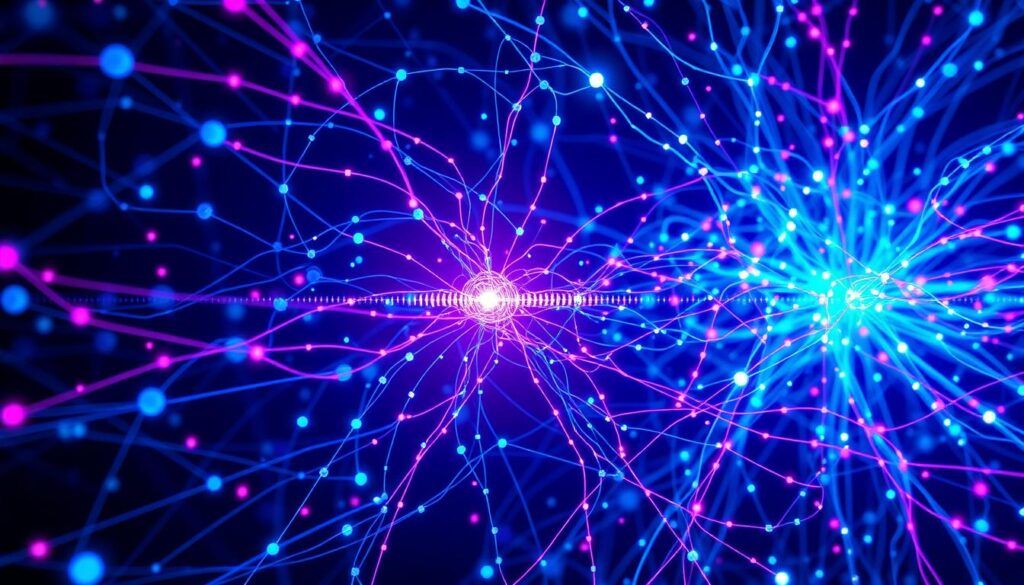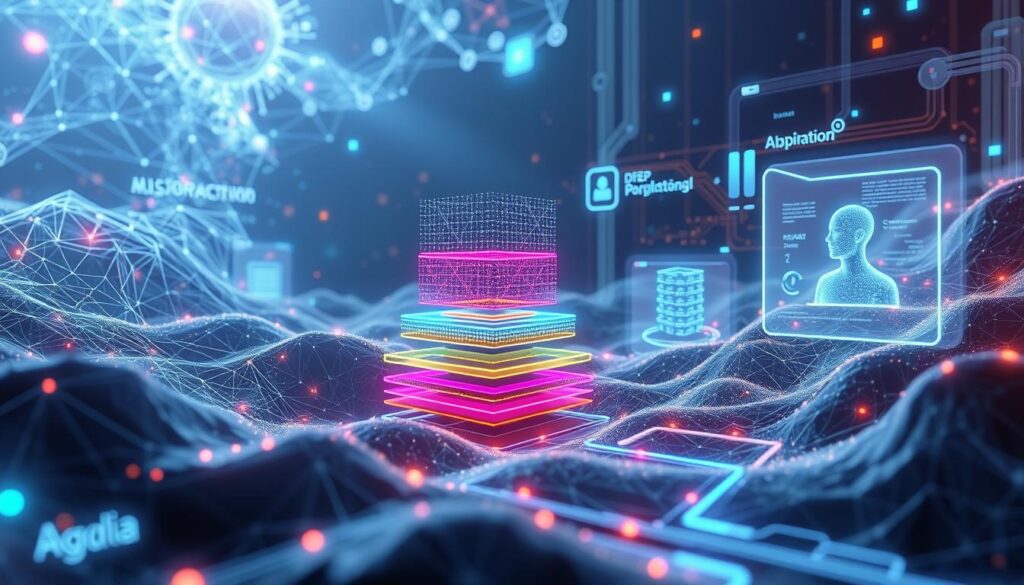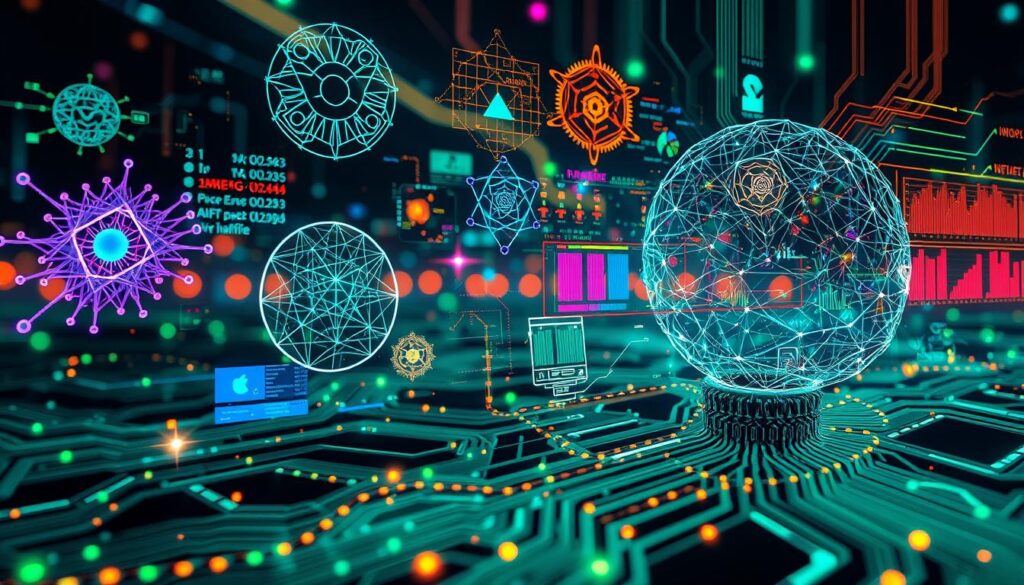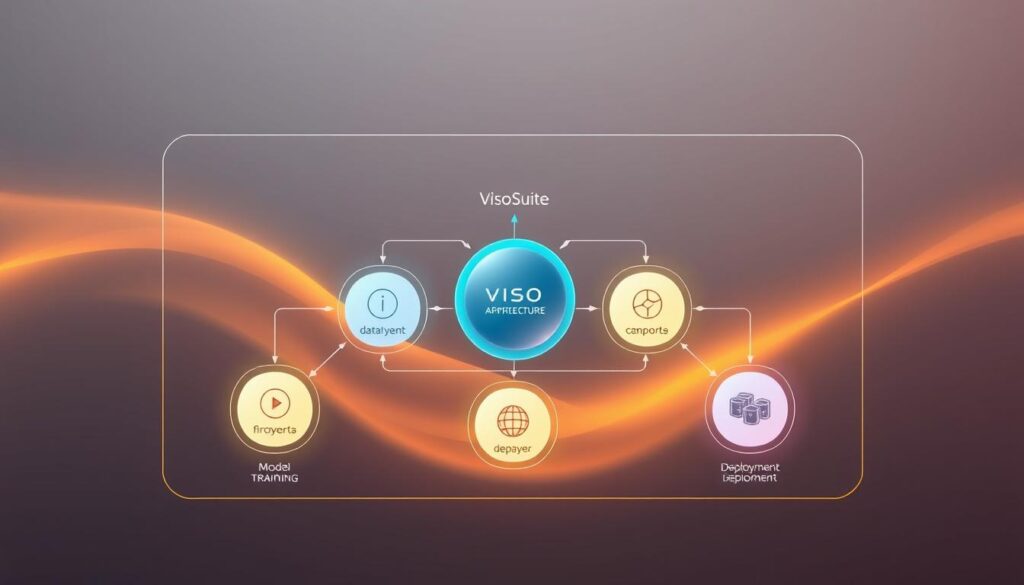FTC disclaimer: This post contains affiliate links and I will be compensated if you make a purchase after clicking on my link.
Artificial intelligence (AI) is changing fast, with deep learning leading the way. It’s making big waves in many fields. But, with so many deep learning software options, picking the right one can be tough. This article will look at the top deep learning tools, their features, and how they compare.
Deep learning is a key part of AI, making huge strides in computer vision, language processing, and predictive analytics. Businesses and researchers are eager to use this tech. They need deep learning software that’s strong and easy to use. The market offers many choices, each with its own strengths and weaknesses.
So, what are the best deep learning software tools out there? How do you pick the right one for your team? By the end of this article, you’ll know the top deep learning tools, their costs, features, and what to look for when choosing the best AI solution for your needs.
Key Takeaways
- Explore the leading deep learning software options, including TensorFlow, PyTorch, Keras, and CNTK.
- Understand the unique features, pricing, and target use cases of each deep learning framework.
- Discover industry-specific deep learning solutions tailored for healthcare, finance, and logistics.
- Learn about the latest advancements and trends in the deep learning software market.
- Gain the knowledge to make an informed decision on the best deep learning tool for your organization.
What is Deep Learning?
Deep learning is a key part of Artificial Intelligence (AI). It uses artificial neural networks to solve complex problems. These networks have many layers, helping them understand data well.
They can do things like recognize speech and track objects. This makes them very useful in many areas.
Brief Introduction to Deep Learning
Deep learning works because of its layered structure. Each layer learns from the last one. This way, they get better at understanding data.
They are great at handling unstructured data like images and videos. This makes them very good at tasks that need complex understanding.
Characteristics of Deep Learning
- Ability to perform tasks like speech recognition, pose estimation, and object tracking
- Dependence on significant computing resources and large datasets for model training
- Utilization of multi-layered artificial neural networks to extract features and patterns from data
- Capacity to learn complex, non-linear relationships in data through the hierarchical structure of deep neural networks
- Suitability for a wide range of applications, including computer vision, natural language processing, and predictive analytics
Deep learning opens up new possibilities for businesses. It can help in medical diagnostics and improve customer service. As it grows, its impact will only get bigger.

“Deep learning is the future of Artificial Intelligence, enabling computers to learn and make decisions in a more human-like manner.”
Deep Learning Applications
Deep learning is a game-changer in artificial intelligence. It has changed many industries and opened new doors. It’s used in healthcare, finance, and speech recognition, showing its wide range of uses.
Healthcare and Medical Imaging
In healthcare, deep learning has made big strides. It helps with medical imaging and finding diseases early. Deep learning can look at scans like X-rays and find problems like tumors.
This tech helps doctors make better and quicker diagnoses. It leads to better care for patients.
Financial Analysis and Trading
The finance world has also seen the benefits of deep learning. It can look at lots of financial data to make smart investment choices. This could change how we invest and manage money.
Speech Recognition
Deep learning has also improved speech recognition. It makes speech-to-text systems work better. This tech is used in virtual assistants and AI that talks to us.
Deep learning is making a big difference in many areas. As it gets better, we’ll see even more amazing things. It will change how we live and work.

Best Deep Learning Software
Deep learning software is changing the game in artificial intelligence and machine learning. It’s making big waves in healthcare, finance, and more. The top deep learning software help developers and scientists do amazing things.
Some top picks include Viso Suite, DeepLearningKit, and H2O.ai. Microsoft Cognitive Toolkit, Torch, and Keras are also favorites. Each tool has its own special features, meeting the needs of the AI world.
Viso Suite is a top choice for computer vision. It’s used by big names and startups alike. DeepLearningKit works on Apple devices, making AI easy to use. H2O.ai is free and works well with Hadoop and Spark.
| Deep Learning Software | Pricing | Key Features |
|---|---|---|
| Viso Suite | Pricing upon request | End-to-end computer vision infrastructure, used by Fortune 500 companies |
| DeepLearningKit | Open-source | Supports pre-trained deep learning models on Apple devices with GPUs |
| H2O.ai | Open-source | Free and open-source deep learning platform, integrates with Hadoop and Spark |
| Microsoft Cognitive Toolkit (CNTK) | Open-source | Scalable, fast, and compatible with multiple programming languages |
| Torch | Pricing upon request | Efficient open-source deep learning library with GPU support |
| Keras | Open-source | Simplistic and flexible deep learning API, works as an interface for TensorFlow and Theano |
Whether you’re new to AI or an expert, these top deep learning software are worth exploring. They open up new doors in artificial intelligence.

Viso Suite – End-to-End Deep Learning Platform
Viso Suite is a top choice in the fast-changing world of artificial intelligence. It’s a complete computer vision platform. It helps teams make, use, and grow AI apps quickly and accurately.
Features and Benefits of Viso Suite
Viso Suite is a 9-in-1 solution for all kinds of needs. It has:
- No-code automation for quick app development and use
- Secure data handling with full privacy, keeping info safe
- Custom editions for any team, with unlimited users and apps
- Flexible services for all sizes, from help to full AI service
AI Architecture and Acceleration
Viso Suite’s AI design boosts computer vision solutions. It supports many deep learning frameworks, like viso suite deep learning models, viso suite features, and viso suite ai architecture. It works well with big names like PyTorch, TensorFlow, and OpenVINO.
With Viso Suite, companies can use AI fully. They can automate tasks, make smart choices, and give great customer service. As AI software needs grow, Viso Suite is a key player. It helps teams, scientists, and developers create new and better apps.
“Viso Suite is the world’s only end-to-end computer vision application platform, offering a comprehensive solution that simplifies the entire AI development lifecycle.”

TensorFlow
TensorFlow is an open-source library for dataflow and differentiable programming. It was developed by the Google Brain team. It’s mainly used for machine learning and deep neural network research.
TensorFlow is very flexible and modular. It has great community support. It works well for both small and big applications.
Advantages of TensorFlow
The main benefits of TensorFlow are:
- Flexibility: TensorFlow can handle a wide range of machine learning tasks. This includes simple tasks and complex deep neural networks.
- Scalability: It can run on many CPUs, GPUs, or even in the cloud. This makes it perfect for big projects.
- Community Support: TensorFlow has a huge community. They offer lots of resources, tutorials, and pre-trained models.
- Production-Ready: It’s used a lot in production. It supports deployment to mobile and edge devices. It also has tools like TensorFlow Serving and TensorFlow Extended.
Drawbacks of TensorFlow
TensorFlow is a strong deep learning framework but it has some downsides:
- Steep Learning Curve: It’s hard for beginners to start with. This is because of its complex API and the need to understand concepts like computational graphs and tensors.
- Less Intuitive: TensorFlow’s syntax and operations can be tricky. This makes it harder to debug and improve quickly.
- Performance Overhead: Its flexibility and scalability can lead to higher performance overhead. This is especially true for smaller models or simpler tasks.
Despite these issues, TensorFlow is still very popular. This is because of its vast ecosystem of tools, libraries, and pre-trained models. It also has strong support from the Google Brain team and the machine learning community.
Keras
Keras is a big deal in deep learning. It’s a Python library that makes working with neural networks easy. It’s known for being simple and easy to use, even for complex tasks.
One of the best things about keras framework is how it makes things easier. Waymo says Keras has made their work a lot simpler. It helps them go from idea to working model fast.
Big names like CERN, NASA, and NIH use Keras. It’s great for solving tough problems and works well in real-world situations. This makes it a top pick for many.
Keras has helped some of the biggest companies in the world. It’s used in YouTube’s recommendation system, for example. People love it because it’s easy to use and understand.
| Feature | Benefit |
|---|---|
| Intuitive and modular API | Simplifies the development workflow and reduces cognitive load |
| Flexible and scalable | Supports research implementations and large-scale production deployments |
| Seamless integration with other libraries | Enables model creation and deployment across framework boundaries |
| Clear documentation and community support | Makes deep learning more accessible for academics, industry, and students |
In short, Keras is a powerful tool for deep learning. It makes complex tasks simple. Its ease of use and strong support make it a great choice for many projects.
PyTorch
PyTorch is a top deep learning framework made by Meta AI. It’s known for its dynamic computation and fast GPU use. It’s loved by many because it’s easy to use and flexible.
Dynamic Computation in PyTorch
PyTorch’s big plus is its dynamic graph. It lets you change the network as you go. This is great for quick tests and small projects.
GPU Acceleration with PyTorch
PyTorch works well with GPUs for faster model training. It uses NVIDIA’s CUDA for this. This is key for tasks that need quick results.
PyTorch has over 100 projects for different tasks. It’s good for many things like image making and finding odd data points. Its flexibility and GPU support make it a favorite among deep learning fans.
| Feature | PyTorch | TensorFlow |
|---|---|---|
| Computational Graph | Dynamic | Static |
| Distributed Training | Supports Data Parallelism | Requires Manual Coding |
| Visualization | Visdom (Limited Features) | TensorBoard (Robust Features) |
| Production Deployment | Requires Additional Frameworks | TensorFlow Serving |
PyTorch and TensorFlow both have their strengths. TensorFlow is better for big projects and showing off results. PyTorch is great for quick tests and new ideas in pytorch deep learning, pytorch dynamic computation, and pytorch gpu acceleration.
Microsoft Cognitive Toolkit (CNTK)
The Microsoft Cognitive Toolkit, or CNTK, is a strong deep learning framework by Microsoft. It’s great at handling big tasks and supports many types of neural networks. This makes it perfect for tasks like image and speech recognition.
CNTK works well with many GPUs and machines. This means it can handle huge models and lots of data. It’s great for tasks like image recognition, speech processing, and understanding natural language.
CNTK can be used for many deep learning tasks. It supports feedforward, CNNs, and RNNs. This lets users customize it for their projects, whether it’s image, speech, or language processing.
But, CNTK’s API might be harder to use than some other frameworks. It also has a smaller community than TensorFlow and PyTorch. This can make finding help and resources harder. Yet, for those needing a fast, scalable deep learning solution, CNTK is still a good choice.
The Microsoft Cognitive Toolkit (CNTK) views neural networks as a series of steps in a graph. It supports models like feed-forward DNNs, CNNs, and RNNs/LSTMs. Since 2015, CNTK has been open-source. Its latest version, 2.7, fully supports ONNX 1.4.1 for exporting models.
In summary, CNTK is a top-notch deep learning framework. It shines in scalability, hardware use, and supports many neural network types. Its API might be tricky, but CNTK is still a top pick for those needing a powerful, flexible deep learning tool.
Apache MXNet
Apache MXNet is a top choice in deep learning. It’s flexible and fast, meeting many developer needs. Unlike others, MXNet mixes flexibility with high performance well.
Flexibility: The Hallmark of Apache MXNet
MXNet shines with its flexibility. It works with many languages like Python, C++, and more. This lets developers use their favorite languages.
MXNet also has a hybrid programming model. It combines symbolic and imperative programming. This gives developers the best of both worlds for their projects.
Performance and Scalability: Powering Large-Scale Deep Learning
MXNet is not just flexible but also fast and scalable. It’s great for big deep learning tasks. It manages memory well, perfect for big data and complex tasks.
MXNet also supports training on many GPUs and machines. This lets developers use all their hardware. It’s fast and efficient for big projects.
MXNet works well with AWS and on edge devices too. This shows it’s adaptable for many settings, from cloud to embedded systems.
For projects like image recognition or natural language processing, MXNet is a great pick. Check out MXNet projects or MXNet training to learn more.
Caffe 2
Caffe 2 is a top choice in deep learning frameworks. It was made by Facebook’s AI Research lab. It’s open-source and focuses on being fast and flexible.
This framework is great for many deep learning tasks. It works well for both small mobile apps and big projects.
Caffe 2 has a special design. It lets developers change and add to it easily. This makes it perfect for those who want to make and use caffe 2 deep learning models well.
But, Caffe 2 might be harder for new users. It’s not as easy as some other frameworks like caffe 2 framework. Still, it has a big community and keeps getting better. This means there are lots of resources to help you start and do well with your projects.
- Modular and customizable architecture
- Focus on performance and speed
- Suitable for mobile deployment and large-scale production
- Strong community support and ongoing development
If you’re into deep learning, Caffe 2 is worth looking at. It offers a mix of flexibility, speed, and scalability. This makes it a good pick for many deep learning tasks.
“Caffe2 is primarily a production option, while Torch is seen as a research option, according to Yangqing. The two teams are collaborating closely to deliver fast deep learning applications.”
Theano
Theano is a key player in deep learning frameworks. It was created by the AI research team at the University of Montreal. Even though it’s no longer being developed, Theano’s impact is still felt. It’s known for its fast numerical tasks and support for GPU acceleration.
Numerical Computation with Theano
Theano is an open-source library for math expressions. It works well with NumPy, a library for scientific computing in Python. This makes Theano great for solving complex problems. It also uses GPU acceleration to boost performance, especially in theano deep learning and other tasks that need lots of computing power.
Theano is good at differentiating expressions, which is key for training deep neural networks. This helps in calculating gradients, a step in optimizing the model’s parameters. Theano’s symbolic computation also leads to better code and faster performance.
“Theano has been a game-changer in the field of theano numerical computation, providing researchers and practitioners with a powerful tool for tackling complex numerical problems.”
Even though Theano might not be easy for beginners, it still has a dedicated following. Its contributions to deep learning are significant. As deep learning keeps growing, Theano’s legacy and insights will keep shaping its future.
Sci-kit Learn
Sci-kit Learn is a free, open-source machine learning library. It works well with the Python programming language. It has many algorithms and tools for tasks like classification, regression, and clustering.
It’s known for being easy to use and having great support. This makes it perfect for both newbies and seasoned data scientists.
Scikit learn focuses on being simple and easy to get into. Its API is clean and easy to use. This helps beginners start with scikit learn machine learning quickly.
- Comprehensive library of machine learning algorithms: Scikit learn has a wide range of algorithms. This includes everything from linear regression to decision trees and random forests.
- Strong documentation and community support: The library’s detailed documentation and active community help users solve problems. They also keep up with the latest updates.
- Seamless integration with other Python libraries: Scikit learn works well with popular Python libraries like NumPy, SciPy, and Matplotlib. This makes data analysis smooth and efficient.
Scikit learn isn’t the best for deep learning tasks. It supports some basic neural networks but lacks the features of TensorFlow or PyTorch. For deep learning, you might need a different tool.
Despite this, scikit learn is a powerful library for many tasks. It’s simple, flexible, and has a strong community. It’s a great choice for both new and experienced users.
Pandas and NumPy
Pandas and NumPy are key open-source libraries for data work in machine learning and pandas deep learning projects. Pandas helps with data handling and works well with other tools. NumPy deep learning is great for math and has many functions for numbers.
These libraries are basic for deep learning and work well with other frameworks. Python has over 137,000 libraries, making it very useful for data work.
The Power of Pandas
Pandas changes data analysis and machine learning. It has easy-to-use data structures and can handle data well. It works well with other libraries like NumPy and Matplotlib, making it key for pandas deep learning.
Numerical Prowess with NumPy
NumPy deep learning is great for numbers and science. It has many functions and does math fast. It works with SciPy and Matplotlib, making it better for data and pictures.
Pandas and NumPy together are very powerful. They help make deep learning apps strong and big. As we need more data insights and machine learning, these libraries are very important.
| Library | Key Features | Applications |
|---|---|---|
| Pandas |
|
|
| NumPy |
|
|
In conclusion, Pandas and NumPy are very important for pandas deep learning and numpy deep learning. They help data scientists and researchers solve big data problems well.
Comparison of Deep Learning Tools
The world of deep learning software is always changing. It’s key to know the main features and differences between the various frameworks. This guide will help you pick the right deep learning tools for your projects.
Deep Learning Tools and Frameworks
| Tool/Framework | Key Features | Strengths | Weaknesses |
|---|---|---|---|
| TensorFlow |
|
|
|
| PyTorch |
|
|
|
| Apache MXNet |
|
|
|
These are just a few examples of deep learning tools and frameworks. Each has its own strengths and weaknesses. When picking a deep learning solution, think about your needs, project complexity, and where you’ll deploy it. Also, consider the community support and documentation available.
Conclusion
This article has given a detailed look at top deep learning software tools and frameworks. We’ve explored their key features, benefits, and downsides. This helps readers choose the best deep learning tools for their AI projects.
The world of deep learning is always changing. This article is a helpful guide through the growing AI technology landscape. As more advanced machine learning is needed, picking the right software is key for staying ahead.
Whether you’re a data scientist, machine learning engineer, or business leader, this article is for you. It shows the strengths and weaknesses of top deep learning software. This knowledge helps you make better choices for your needs and goals. By knowing what each solution offers, you can improve your deep learning work and achieve your AI goals.








